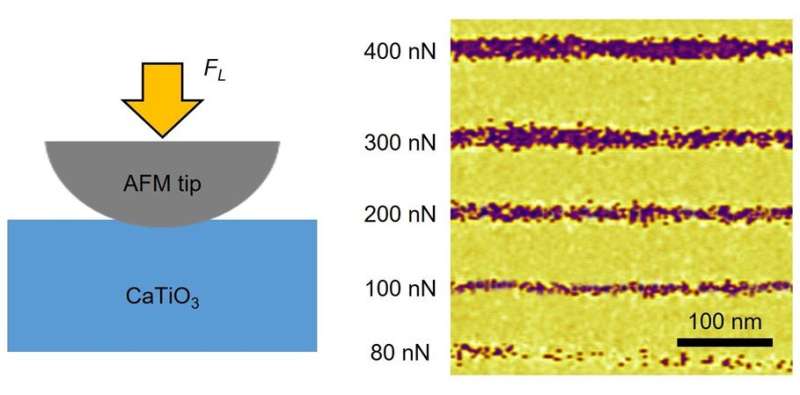
A method to draw data in an area smaller than 10 nanometers has been proposed in a recent study published in Physical Review Letters
A joint research team led by Professor Daesu Lee (Department of Physics) of POSTECH, Professor Se Young Park (Department of Physics) at Soongsil University, and Dr. Ji Hye Lee (Department of Physics and Astronomy) of Seoul National University has proposed a method for densely storing data by “poking” with a sharp probe. This method utilizes a material in the metastable state, whose properties change easily even with slight stimulation.
A thin film of metastable ferroelectric calcium titanate (CaTiO3) enables the polarization switching of a material even with a slight pressure of a probe: A very weak force of 100 nanonewtons (nN) is more than enough. The joint research team succeeded in making the width of the polarization path smaller than 10 nm by using this force and found the way to dramatically increase the capacity of data storage. This is because the smaller the size of the path, the more data the single material can store.
The data storage capacity increased by up to 1 terabit (Tbit)/cm as a result of drawing the data storage area using a probe on the thin film. This result is 10 times greater than that of a previous study (0.11 Tbit/cm²) which suggested a probe-based storage method using another material. Unlike the data storage method that uses electric fields, this probe method only requires a very small force, so the burden on the device is also small.
The results from the study are drawing attention as they have proved that materials achieve higher performance in an unstable metastable state. The findings are anticipated to be applicable in next-generation electronic devices with improved integration and efficiency in the future.
More information:
Ji Hye Lee et al, Flexoelectricity-Driven Mechanical Switching of Polarization in Metastable Ferroelectrics, Physical Review Letters (2022). DOI: 10.1103/PhysRevLett.129.117601
Journal information:Physical Review Letters
Provided by
Pohang University of Science & Technology (POSTECH)

READ MORE
5 Ways Mobile Banking Alerts Can Benefit You
Mobile alerts give cardholders extra security. Pando Hall/Photographer’s Choice RF/Getty Images Some people are only [...]
Footprints Found at Ancient Hot Springs Could Represent Earliest Settlement of Tibetan Plateau
Caption: Six pairs of hand and footprints were discovered in 1998, including two that are [...]
How to Build a Human Voice
A new process is giving human voices to people with speech disabilities. Flickr user Miikka [...]
How Does Alcohol Make You Drunk?
If one drink makes you feel good, why do five make you feel like throwing [...]
A New Meaning to Green Urban Design: Dyeing the Chicago River
A high resolution photo of the Chicago River on St. Patrick’s Day Mike Boehmer via [...]
Were Witches Really Burned at the Stake in Salem?
This lithograph of the Salem witch trials shows how mass hysteria took over Salem Village. [...]
Viral surface-inspired nanocarriers for improved oral insulin therapy
Schematic illustrations of composition and mechanism of Pep/Gal-PNPs for oral insulin delivery. a The construction [...]
Nanocrystals made from amalgam of two metals
Intermetallic nanocrystals (electron microscope images) made from different combinations of metals. The white bar indicates [...]